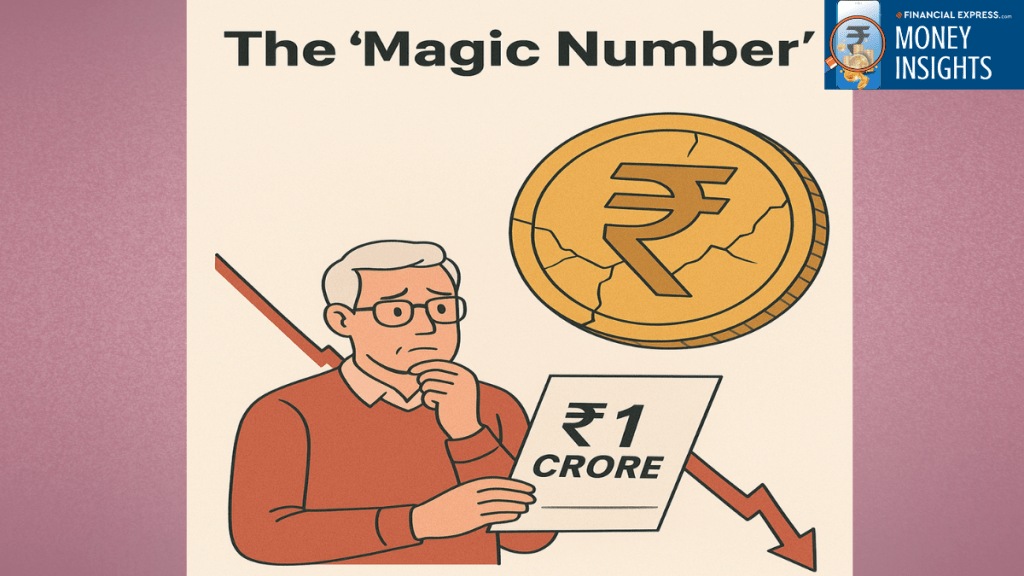I’ve watched two generations retire in my family – my father and my grandfather. And both of them had visibly different retirements.
While my grandfather comfortably stepped away with just a few lakhs in the bank. It was enough for him. He lived pleasantly, travelled when he wanted, and never seemed too anxious about running out of money. On the contrary, he also built a family home, just before his retirement!
But for my father, the numbers had shifted. His retirement “magic figure” was a crore. When he spoke about saving a crore for his golden years, it felt like fortune. Sufficient to cover healthcare, daily expenses and maybe even a few luxuries.
But here’s the truth no one likes to admit: numbers don’t stay magical forever. What seemed like financial security for one generation can look bitterly inadequate for the next. And if you, like me, are planning for retirement, you need to face a hard fact: ₹1 crore is not what it used to be.
The Shrinking Value of Money
Think of inflation as a silent termite. It doesn’t eat your savings in a day, but slowly gnaws away until one day you realise the foundations are hollow.
By 2045, ₹1 crore may have the purchasing power of just ₹30 lakh today. Even at a modest 4% inflation rate, it shrinks to about ₹45 lakh. That means your “ideal retirement corpus” is already outdated.
Now compare your purchasing power with real-world costs:
- Healthcare costs in India are set to rise to 13%, higher than last year’s 12% and well above the global average of 10%.
- A child’s undergraduate international courses can easily cost upwards ₹50 lakhs, per annum.
- Add lifestyle upgrades, travel, or even basic comforts and the gap only widens.
Suddenly, the zeroes in a crore don’t feel like security. And that fool-proof retirement plan you had, well it doesn’t look all that golden.
Why Today’s Low Inflation Won’t Save You
You might say, “But inflation is low right now.” True. In July 2025, consumer inflation dropped to 1.55%, the lowest since 2019. Household expenses felt lighter because vegetables got cheaper and transport costs eased.
But here’s the catch.
Short-term dips don’t change long-term trends. Over the last few decades, India’s inflation has averaged 5–6%. And when it comes to specific goals like healthcare, education, travel, the rate is often higher.
So while your monthly grocery bills feel manageable today, retirement is a long journey. With the average life expectancy increasing from 62 in 1990 to over 70 now, inflation will compound just as vigorously as your investments.
How to Beat Inflation
Here’s what smart retirement planning looks like in 2025:
1. Stop chasing “magic numbers.”
Don’t stick to numbers. Whether it’s ₹1 crore, ₹5 crore, or even ₹10 crore. Your number is one that matches your purchasing power. So, instead of asking, “How much is enough?” ask, “Will my money keep up with costs?”
2. Plan with realistic inflation rates.
Ignore today’s 1.55%. Plan your life with at least 6% inflation for daily expenses, and 8–10% for lifestyle goals.
3. Balance safety with growth.
Traditional saving instruments like FDs won’t help you get ahead. Your portfolio needs equity exposure through a mix of aggressive and balanced SIP funds or even index funds to outrun inflation over decades.
4. Bucket your goals.
- Plan conservatively for essentials like food and healthcare.
- Aspirational goals like travel, weddings or property require more aggressive planning.
- And lastly, keep a part of your portfolio liquid for emergencies.
5. Review every 3 years.
A corpus that felt “enough” three years ago can look outdated today. Keep reviewing and adjusting your savings as inflation and your lifestyle evolve.
The Bottom Line
When my grandfather retired, he never worried about inflation. My father’s generation started to feel its bite. For us, it’s impossible to ignore.
The lesson is simple: don’t let today’s numbers fool you. A crore may sound like a lot, but in the real world of 2045, it can feel alarmingly small.
So whether you’re saving ₹5,000 a month or building a multi-crore portfolio, the rule is the same: don’t just chase a number. Chase purchasing power.
Because when you finally hang up your boots, the last thing you want is to realise your “magic figure” was a sham.
Disclaimer
Note: The purpose of this article is to share insights, data points, and thought-provoking perspectives on investing. It is not investment advice. If you wish to act on any investment idea, you are strongly advised to consult a qualified advisor. This article is strictly for educational purposes. The views expressed are personal and do not reflect those of my current or past employers.
Sneha Virmani is a content strategist and writer with over a decade of experience. She is an alumna of Lady Shri Ram College, Delhi University (Economics & Psychology). Sneha specialises in storytelling-led content strategies and consumer education campaigns. Her work brings context and clarity, with a no-jargon approach designed to engage everyday readers.
Disclosure: The writer and his dependents do not hold the stocks discussed in this article. The website managers, its employee(s) and contributors/writers/authors of articles have or may have an outstanding buy or sell position or holding in the securities, options on securities or other related investments of issuers and/or companies discussed therein. The content of the articles and the interpretation of data are solely the personal views of the contributors/ writers/authors. Investors must make their own investment decisions based on their specific objectives, resources and only after consulting such independent advisors as may be necessary.

